Forecasting of Energy Demands for Smart Home Applications
Abstract
1. Introduction
2. Literature Review
3. System Model
3.1. Control Model
- Ki,t is defined as the total occupants within a region or zone i over time slot t,
- is the minimum indoor temperature at an acceptable level over the zone i and
- is the maximum indoor temperature at an acceptable level over the zone i.
- T i,t is indoor room zone temperature i,
- Tz,t is adjacent zones at the time slot t,
- is the outdoor temperature over the time slot t,
- mi,t is the rate of air supply at the zone i over the time slot t,
- ςi,t is the thermal disturbance over zone i over the time slot t,
- Ni is defined as the neighboring set across zone i,
- is the CO2 level (ppm),
- τ is the time slot duration (ms),
- κ is the density of air (kg/m3),
- ϑi is the volume of zone i (m3),is the level of concentration of CO2 in the mixed air at the time slot t, with ,
- χ is the generation of CO2 level per person and
- σt is the damper position in the air handling unit.
3.2. HVAC Energy Cost Model
- Ca is defined as the specific heat of the air at 300 Kelvin,
- η is defined as the efficiency of the coolant,
3.3. Energy Cost Minimization Problem
4. Proposed CRNN Model
4.1. Hybrid CRNN for Prediction of Energy Consumption
| Algorithm 1: Prediction Using the CRNN |
| 1: Recognition and prediction module estimate all three parameters |
| 2: Parameters are power loss, reactive power loss and cost of energy consumption from the surroundings. |
| 3: It sends the output to the prediction module. |
| 4: Recognition module using the CNN classifies predictable and unpredictable classes (behavior). |
| 5: It updates continuously in an iterative manner to achieve the task of accurate predictive behavior. |
| 6: Prediction module using the RNN interacts actively to the changes (predictable and unpredictable classes) to the indicated task. |
| 7: RNN makes the planning of future prediction, where the model incorporates the results of the classification (high-energy consumption or low-energy consumption devices for optimal operation of the HVAC devices). |
| 8: The prediction models handle the objective function (with power loss, reactive power loss and cost of energy consumption) in a time-variant mode. |
| 9: It achieves optimal high-quality prediction using the RNN model. |
4.1.1. Recognition
4.1.2. Prediction Using CNN
- Convolutional layers perform the processing operation that is a linear operation when a series of weights is multiplied using the video input data array. A filter is used to scan the entire image, which is referred to as a translation invariance, to detect the saliency from the input image. Since filters are repeatedly used with the input array, a two-dimensional feature map is created.
- Permutation layers confirm the device classified for optimal energy consumption by the convolution layer, which lists the reference objects in the order in a permutation-based representation. The similarity is estimated by using the two permutations rather than using the distance function between the reference object and the ground truth.
4.1.3. Planning Using RNN
- Batch normalization reduces the number of hidden layers required for processing the input features from the CNN. It adjusts the scaling and activation functions to speed up the learning process.
- The batch normalization lowers the number of hidden layers necessary for processing the CNN inputs. It adapts the activation and scaling function to speed up the process of learning.
- Softmax Activation produces a vector that shows a list of potential outcomes in the probability distribution.
- Maximum pooling is a packing process that calculates the maximum or largest value in each patch of every feature map, where the packing and permutation layers are processed.
- Dropout unit ignores a number of hidden units on the forward pass, which are likely to drop the individual nodes so that a reduced network is left; the entry and output edges of a dropped node, on the other hand, are also removable. These operations are performed to prevent overfitting.
- To address the gradient problem, the Bidirectional Gated Recurrent Unit is used to make the operation more rapid and efficient.
5. Results and Discussion
- Li-Fi: Li-Fi is a wireless communication technology that utilizes light to transmit data and the positions between devices.
- Wi-Fi: Wi-Fi is a wireless networking technology that allows devices such as computers, mobile devices and other equipment to interface with the Internet.
- Zigbee: Zigbee is a low-cost, low-power, wireless mesh network standard targeted at battery-powered devices in wireless control and monitoring applications. Zigbee operates on an IEEE 802.15.4 physical radio specification and operates in unlicensed bands including 2.4 GHz, 900 MHz and 868 MHz. The data rate of 250 kbps is essentially be suited for two-way data transmission between the sensors and controllers.
- Bluetooth: Bluetooth is a wireless technology standard used for exchanging data between fixed and mobile devices over short distances using UHF radio waves in the industrial, scientific and medical radio bands, from 2.402 GHz to 2.480 GHz, and building personal area networks. Bluetooth signals are transmitted over short distances, typically between 30 feet, and low-cost transceivers support this in the devices. It further supports the 2.45-GHz band for such data transmission and can support up to 721 KBps along with three voice channels.
5.1. Case Study: Comparison with Different Communication Protocols
5.2. Comparison with Existing Deep Learning Methods on HVAC Systems
5.2.1. Load Balancing Accuracy
5.2.2. Energy Efficiency
5.2.3. Latency
5.2.4. Transmission Rate
5.2.5. Training Loss
6. Conclusions
Author Contributions
Funding
Conflicts of Interest
References
- Tseng, S.P.; Li, B.R.; Pan, J.L.; Lin, C.J. An application of Internet of things with motion sensing on smart building. In Proceedings of the 2014 International Conference on Orange Technologies, Xi’an, China, 20–23 September 2014; pp. 65–68. [Google Scholar]
- Veerappan Kousik, N.G.; Natarajan, Y.; Suresh, K.; Patan, R.; Gandomi, A.H. Improving power and resource management in heterogeneous downlink OFDMA networks. Information 2020, 11, 203. [Google Scholar] [CrossRef]
- Solaimani, S.; Keijzer-Broers, W.; Bouwman, H. What we do–and don’t–know about the smart building: An analysis of the smart building literature. Indoor Built Environ. 2015, 24, 370–383. [Google Scholar] [CrossRef]
- Siekkinen, M.; Hiienkari, M.; Nurminen, J.; Nieminen, J. How low energy is bluetooth low energy? Comparative measurements with ZigBee/802.15.4. In Proceedings of the Wireless Communications and Networking Conference Workshops (WCNCW), Paris, France, 1 April 2012; pp. 232–237. [Google Scholar]
- Yuvaraj, N.; Karthikeyan, T.; Pragash, K. An improved task allocation scheme in serverless computing using gray wolf Optimization (GWO) based reinforcement learning (RIL) approach. Wirel. Pers. Commun. 2020. [Google Scholar] [CrossRef]
- Levy, M. Understanding the Real Energy Consumption of Embedded Microcontrollers. Digikey.com. 2012. Available online: https://www.digikey.com/en/articles/techzone/2012/jun/understanding-the-real-energy-consumption-of-embeddedmicrocontrollers (accessed on 9 December 2020).
- Sivaram, M.; Yuvaraj, N.; Mohammed, A.S.; Manikandan, V.; Porkodi, V.; Yuvaraj, N. Improved enhanced DBTMA with contention-aware admission control to improve the network performance in MANETS. Comput. Mater. Contin. 2019, 60, 435–454. [Google Scholar] [CrossRef]
- Cancellara, S.; Greppi, M.; Dongellini, M.; Fabbri, G.; Biserni, C.; Morini, G.L. Experimental Investigation on the pressure drop of air flows through aluminum and nickel-chromium metallic foams for HVAC applications. Energies 2020, 13, 172. [Google Scholar] [CrossRef]
- Yuvaraj, N.; Suresh Ghana Dhas, C. High-performance link-based cluster ensemble approach for categorical data clustering. J. Supercomput. 2020, 76, 4556–4579. [Google Scholar] [CrossRef]
- Talebi, A.; Hatami, A. Online fuzzy control of HVAC systems considering demand response and users’ comfort. Energy Sources Part B Econ. Plan. Policy 2020, 15, 403–422. [Google Scholar] [CrossRef]
- Song, K.; Jang, Y.; Park, M.; Lee, H.S.; Ahn, J. Energy efficiency of end-user groups for personalized HVAC control in multi-zone buildings. Energy 2020, 206, 118116. [Google Scholar] [CrossRef]
- Danalakshmi, D.; Gopi, R.; Hariharasudan, A.; Otola, I.; Bilan, Y. Reactive power optimization and price management in microgrid enabled with blockchain. Energies 2020, 13, 6179. [Google Scholar] [CrossRef]
- Feng, W.; Wei, Z.; Sun, G.; Zhou, Y.; Zang, H.; Chen, S. A conditional value-at-risk-based dispatch approach for the energy management of smart buildings with HVAC systems. Electr. Power Syst. Res. 2020, 188, 106535. [Google Scholar] [CrossRef]
- Homod, R.Z.; Togun, H.; Abd, H.J.; Sahari, K.S. A novel hybrid modelling structure fabricated by using Takagi-Sugeno fuzzy to forecast HVAC systems energy demand in real-time for Basra city. Sustain. Cities Soc. 2020, 56, 102091. [Google Scholar] [CrossRef]
- Carli, R.; Cavone, G.; Ben Othman, S.; Dotoli, M. IoT based architecture for model predictive control of HVAC systems in smart buildings. Sensors 2020, 20, 781. [Google Scholar] [CrossRef]
- Dey, M.; Rana, S.P.; Dudley, S. Smart building creation in large scale HVAC environments through automated fault detection and diagnosis. Future Gener. Comput. Syst. 2020, 108, 950–966. [Google Scholar] [CrossRef]
- Ni, W.; Ge, Z.; Yang, L.; Du, X. Piping-main scheme for condensers against the adverse impact of environmental conditions on air-cooled thermal power units. Energies 2020, 13, 170. [Google Scholar] [CrossRef]
- Ostadijafari, M.; Dubey, A.; Yu, N. Linearized price-responsive HVAC controller for optimal scheduling of smart building loads. IEEE Trans. Smart Grid 2020. [Google Scholar] [CrossRef]
- Jana, R.L.; Dey, S.; Dasgupta, P. A Hierarchical HVAC control scheme for energy-aware smart building automation. ACM Trans. Des. Autom. Electron. Syst. 2020, 25, 1–33. [Google Scholar] [CrossRef]
- Aguilar, J.; Ardila, D.; Avendaño, A.; Macias, F.; White, C.; Gomez-Pulido, J.; Garces-Jimenez, A. An Autonomic Cycle of Data Analysis Tasks for the Supervision of HVAC Systems of Smart Building. Energies 2020, 13, 3103. [Google Scholar] [CrossRef]
- Salleh, F.H.M.; binti Saripuddin, M.; bin Omar, R. Predicting thermal comfort of HVAC building using 6 thermal factors. In Proceedings of the 2020 8th International Conference on Information Technology and Multimedia (ICIMU), Selangor, Malaysia, 24–26 August 2020; pp. 170–176. [Google Scholar]
- Chen, Y.; Tong, Z.; Zheng, Y.; Samuelson, H.; Norford, L. Transfer learning with deep neural networks for model predictive control of HVAC and natural ventilation in smart buildings. J. Clean. Prod. 2020, 254, 119866. [Google Scholar] [CrossRef]
- Fekri, M.N.; Ghosh, A.M.; Grolinger, K. Generating energy data for machine learning with recurrent generative adversarial networks. Energies 2020, 13, 130. [Google Scholar] [CrossRef]
- Suresh, V.; Janik, P.; Rezmer, J.; Leonowicz, Z. Forecasting solar PV output using convolutional neural networks with a sliding window algorithm. Energies 2020, 13, 723. [Google Scholar] [CrossRef]
- Goncalves, D.; Sheikhnejad, Y.; Oliveira, M.; Martins, N. One step forward toward smart city utopia: Smart building energy management based on adaptive surrogate modelling. Energy Build. 2020, 110146. [Google Scholar] [CrossRef]
- Sendra-Arranz, R.; Gutiérrez, A. A long short-term memory artificial neural network to predict daily HVAC consumption in buildings. Energy Build. 2020, 109952. [Google Scholar] [CrossRef]
- Elnour, M.; Meskin, N.; Al-Naemi, M. Sensor data validation and fault diagnosis using auto-associative neural network for HVAC systems. J. Build. Eng. 2020, 27, 100935. [Google Scholar] [CrossRef]
- Sadeghi, A.; Younes Sinaki, R.; Young, W.A.; Weckman, G.R. An intelligent model to predict energy performances of residential buildings based on deep neural networks. Energies 2020, 13, 571. [Google Scholar] [CrossRef]
- Gavurova, B.; Perzelova, I.; Bencoova, B. Economic aspects of renewable energy use—Application of support schemes based on a particular biogas plant in Slovakia. Acta Montan. Slovaca 2016, 21, 217–228. [Google Scholar]
- Škare, M.; Tomić, D.; Stjepanović, S. Energy consumption and Green GDP in Europe: A panel cointegration analysis 2008–2016. Acta Montan. Slovaca 2020, 25, 46–56. [Google Scholar]
- Nguyen, P.V.; Tran, K.T. Explicating energy saving intention from the prospect of small medium enterprises. Entrep. Sustain. Issues 2020, 8, 716–734. [Google Scholar] [CrossRef]
- Khudyakova, T.; Shmidt, A.; Shmidt, S. Sustainable development of smart cities in the context of the implementation of the tire recycling program. Entrep. Sustain. Issues 2020, 8, 698–715. [Google Scholar] [CrossRef]
- Azuatalam, D.; Lee, W.L.; de Nijs, F.; Liebman, A. Reinforcement learning for whole-building HVAC control and demand response. Energy AI 2020, 2, 100020. [Google Scholar] [CrossRef]
- Yu, L.; Jiang, T.; Zou, Y. Online energy management for a sustainable smart home with an HVAC load and random occupancy. IEEE Trans. Smart Grid 2017, 10, 1646–1659. [Google Scholar] [CrossRef]
- Tittaferrante, A.; Yassine, A. Multi-advisor deep reinforcement learning for thermostatically controlled heating in smart homes. In Proceedings of the 2020 IEEE 8th International Conference on Smart Energy Grid Engineering (SEGE), Oshawa, ON, Canada, 12–14 August 2020; pp. 18–21. [Google Scholar]
- Javed, A.; Larijani, H.; Ahmadinia, A.; Gibson, D. Smart random neural network controller for HVAC using cloud computing technology. IEEE Trans. Ind. Inform. 2016, 13, 351–360. [Google Scholar] [CrossRef]
- Yu, L.; Xie, W.; Xie, D.; Zou, Y.; Zhang, D.; Sun, Z.; Zhang, L.; Zhang, Y.; Jiang, T. Deep reinforcement learning for smart home energy management. IEEE Internet Things J. 2019, 7, 2751–2762. [Google Scholar] [CrossRef]
- Javed, A.; Larijani, H.; Ahmadinia, A.; Emmanuel, R.; Mannion, M.; Gibson, D. Design and implementation of a cloud enabled random neural network-based decentralized smart controller with intelligent sensor nodes for HVAC. IEEE Internet Things J. 2016, 4, 393–403. [Google Scholar] [CrossRef]
- Bui, D.K.; Nguyen, T.N.; Ngo, T.D.; Nguyen-Xuan, H. An artificial neural network (ANN) expert system enhanced with the electromagnetism-based firefly algorithm (EFA) for predicting the energy consumption in buildings. Energy 2020, 190, 116370. [Google Scholar] [CrossRef]
- Zou, Z.; Yu, X.; Ergan, S. Towards optimal control of air handling units using deep reinforcement learning and recurrent neural network. Build. Environ. 2020, 168, 106535. [Google Scholar] [CrossRef]
- Zhang, W.; Hu, W.; Wen, Y. Thermal comfort modeling for smart buildings: A fine-grained deep learning approach. IEEE Internet Things J. 2018, 6, 2540–2549. [Google Scholar] [CrossRef]
- Papadopoulos, S.; Kontokosta, C.E.; Vlachokostas, A.; Azar, E. Rethinking HVAC temperature setpoints in commercial buildings: The potential for zero-cost energy savings and comfort improvement in different climates. Build. Environ. 2019, 155, 350–359. [Google Scholar] [CrossRef]
- Bouktif, S.; Fiaz, A.; Ouni, A.; Serhani, M.A. Multi-sequence LSTM-RNN deep learning and metaheuristics for electric load forecasting. Energies 2020, 13, 391. [Google Scholar] [CrossRef]
- Su, H.; Hu, Y.; Karimi, H.R.; Knoll, A.; Ferrigno, G.; De Momi, E. Improved recurrent neural network-based manipulator control with remote center of motion constraints: Experimental results. Neural Netw. 2020, 131, 291–299. [Google Scholar] [CrossRef] [PubMed]
- Hibat-Allah, M.; Ganahl, M.; Hayward, L.E.; Melko, R.G.; Carrasquilla, J. Recurrent neural network wave functions. Phys. Rev. Res. 2020, 2, 023358. [Google Scholar] [CrossRef]
- Pang, Z.; Niu, F.; O’Neill, Z. Solar radiation prediction using recurrent neural network and artificial neural network: A case study with comparisons. Renew. Energy 2020, 156, 279–289. [Google Scholar] [CrossRef]
- Miyata, S.; Akashi, Y.; Lim, J.; Kuwahara, Y.; Tanaka, K. Model-based fault detection and diagnosis for HVAC systems using convolutional neural network. In Proceedings of the 16th IBPSA Conference, Rome, Italy, 2–4 September 2019. [Google Scholar] [CrossRef]
- Westermann, P.; Welzel, M.; Evins, R. Using a deep temporal convolutional network as a building energy surrogate model that spans multiple climate zones. Appl. Energy 2020, 278, 115563. [Google Scholar] [CrossRef]
- Elnour, M.; Meskin, N. Actuator fault diagnosis in multi-zone HVAC Systems using 2D convolutional neural networks. In Proceedings of the 2020 IEEE International Conference on Informatics, IoT, and Enabling Technologies (ICIoT), Doha, Qatar, 2–5 February 2020; pp. 404–409. [Google Scholar]
- Miyata, S.; Lim, J.; Akashi, Y.; Kuwahara, Y.; Tanaka, K. Fault detection and diagnosis for heat source system using convolutional neural network with imaged faulty behavior data. Sci. Technol. Built Environ. 2020, 26, 52–60. [Google Scholar] [CrossRef]
- Stamatescu, G. HVAC air handling units: One-year data from medium-to-large size academic building. IEEE DataPort 2019. [Google Scholar] [CrossRef]
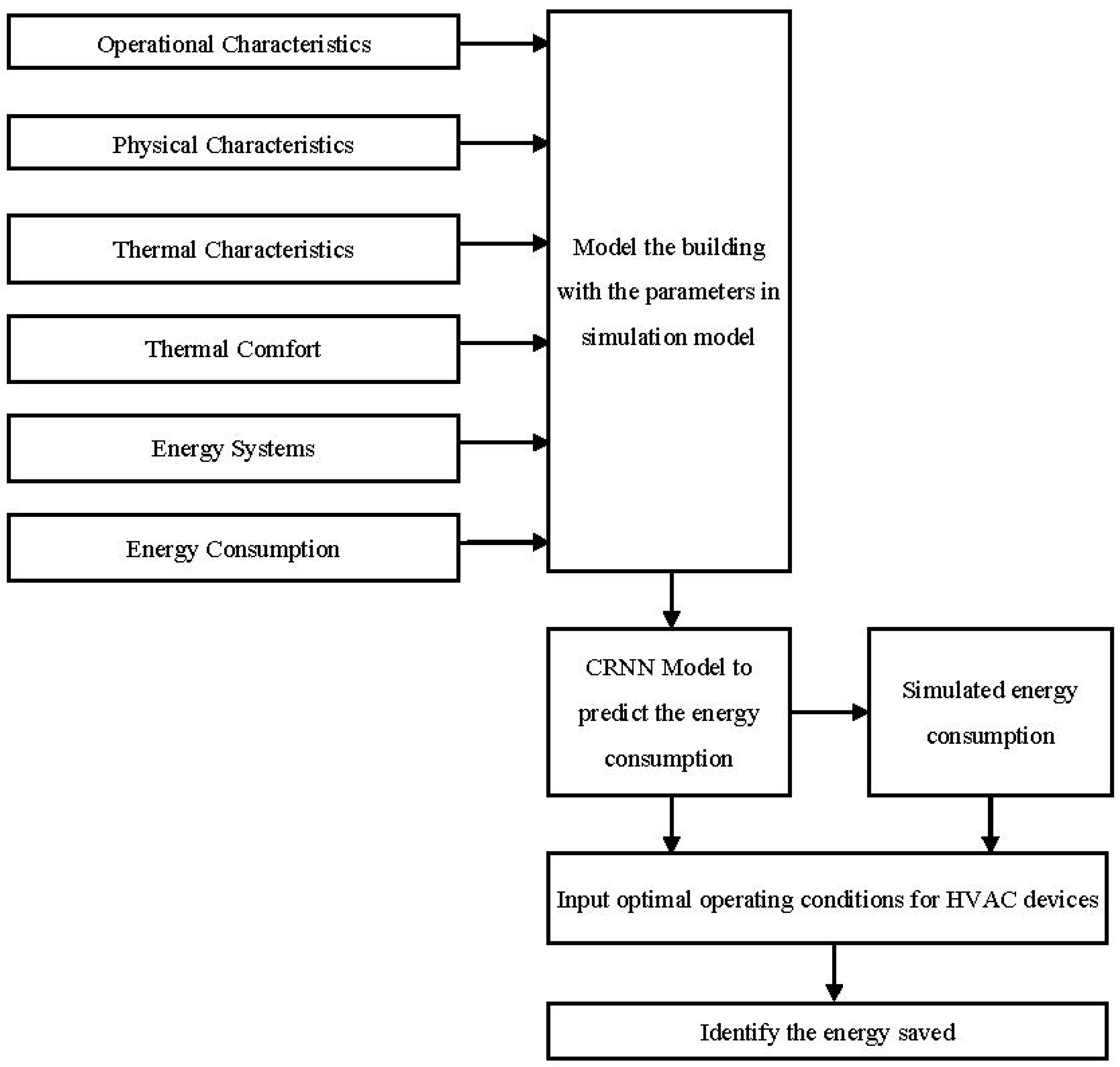
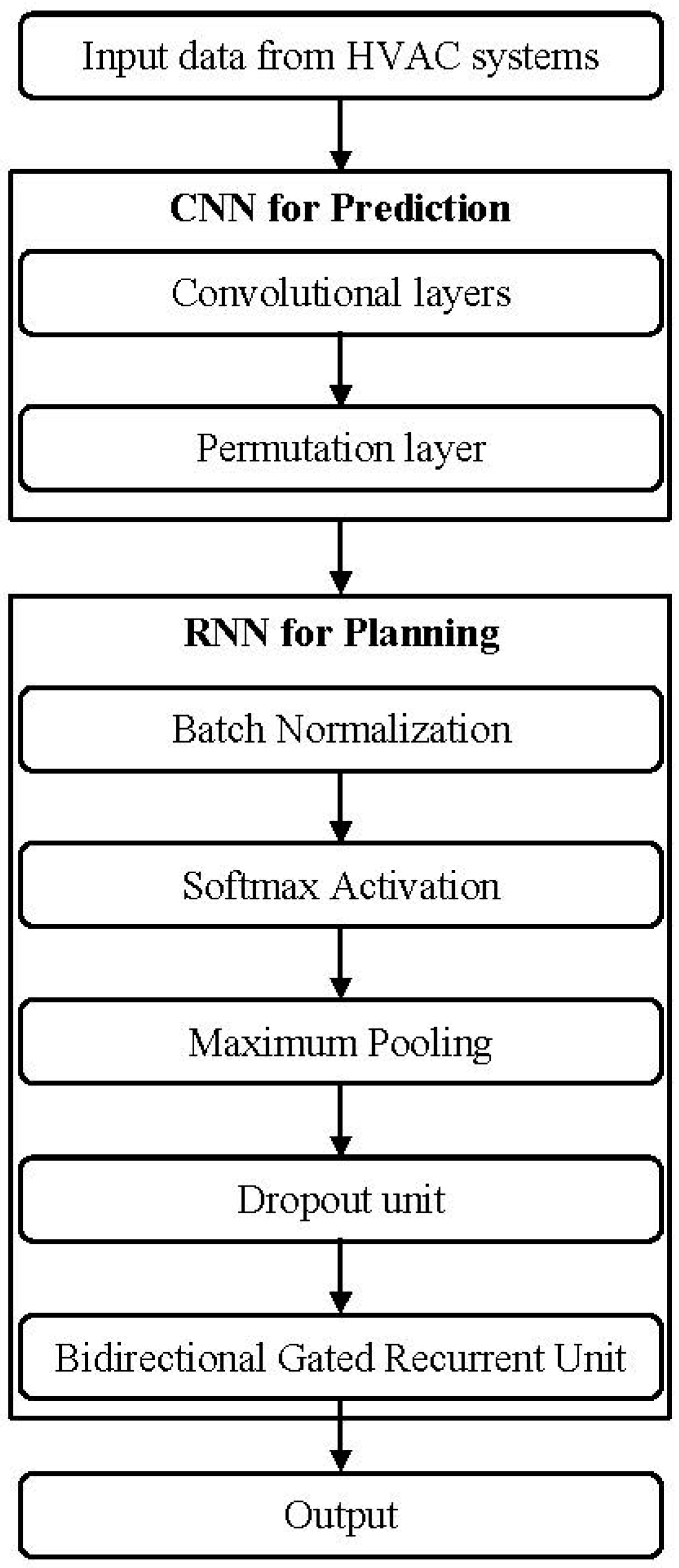
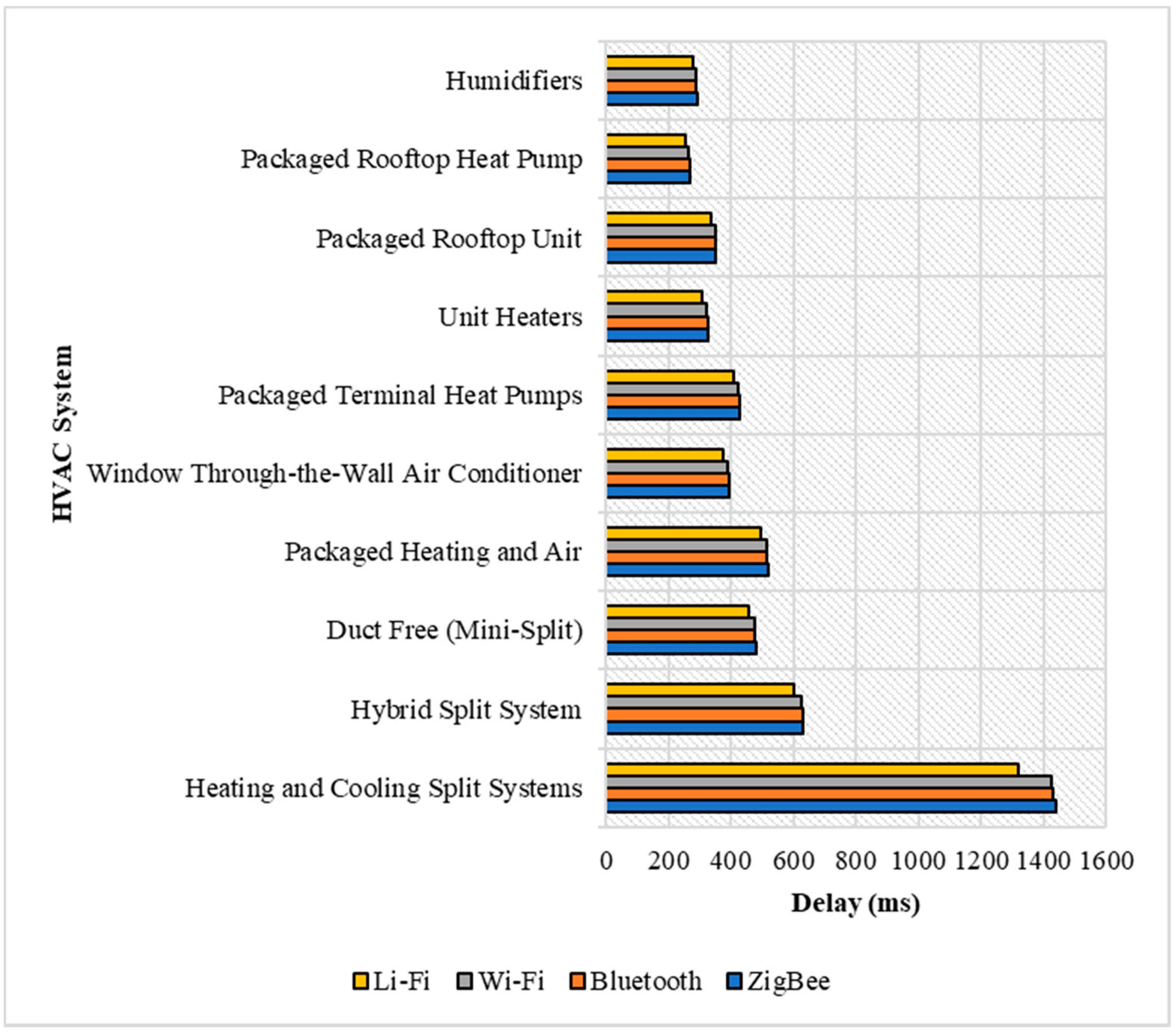
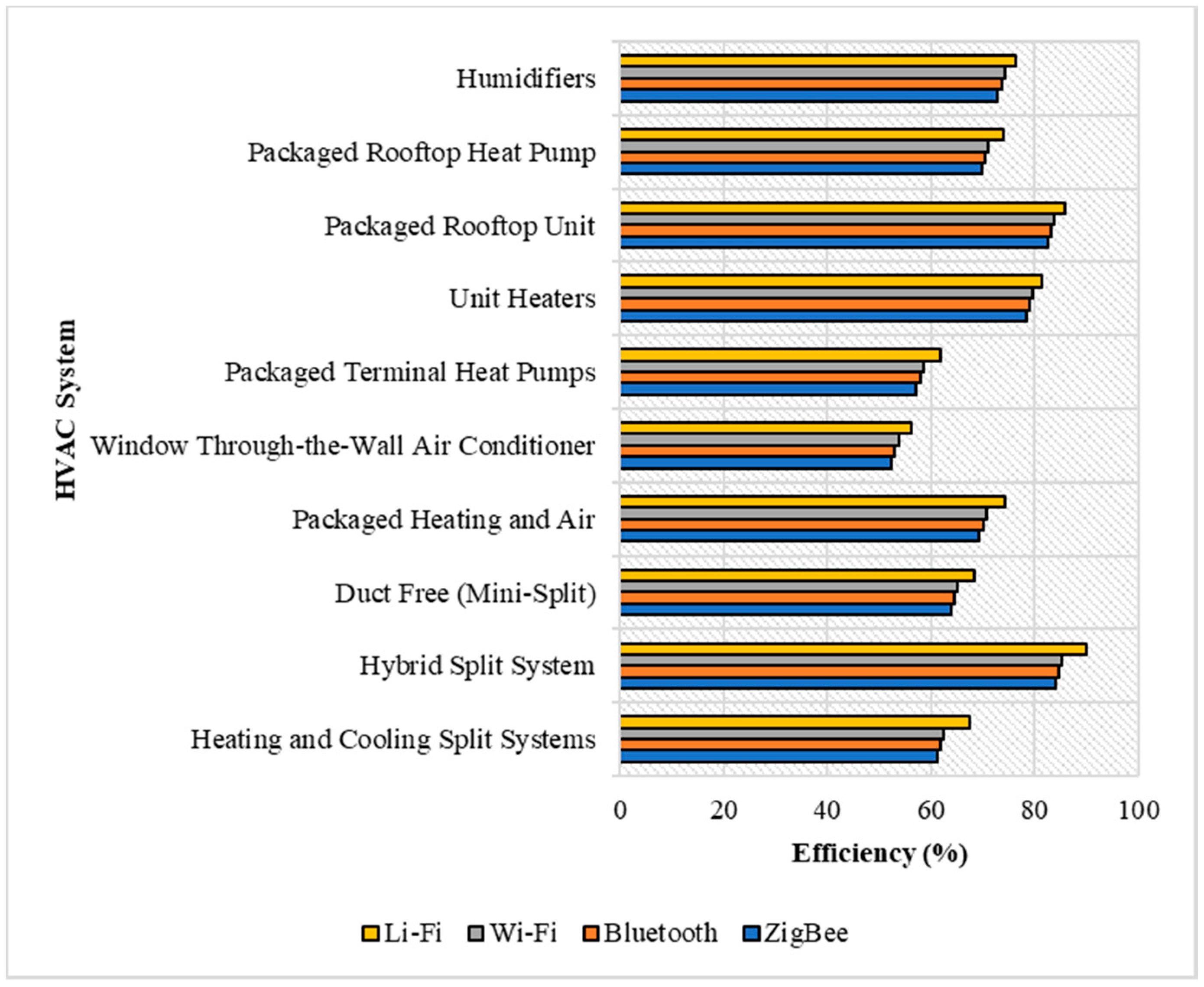
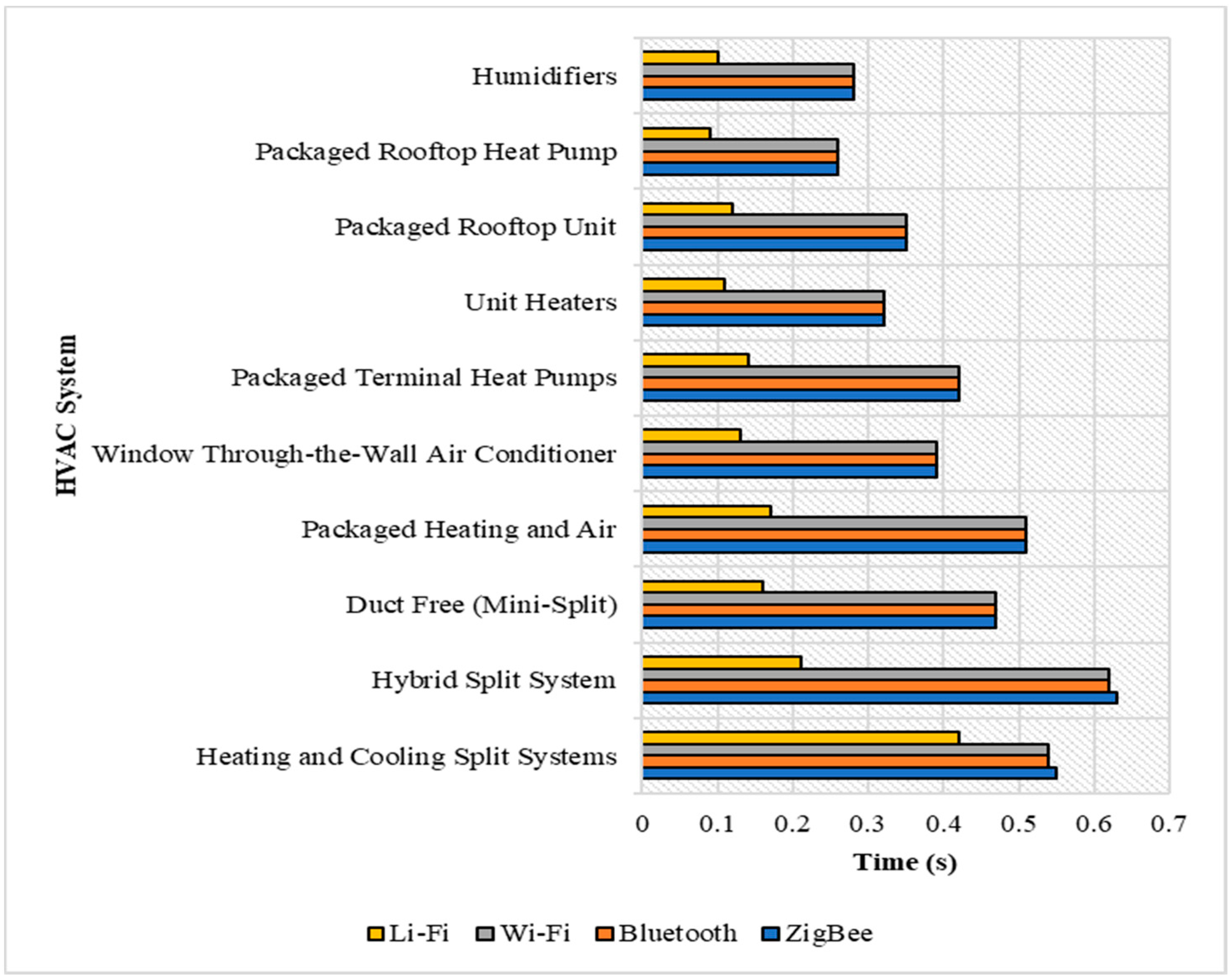
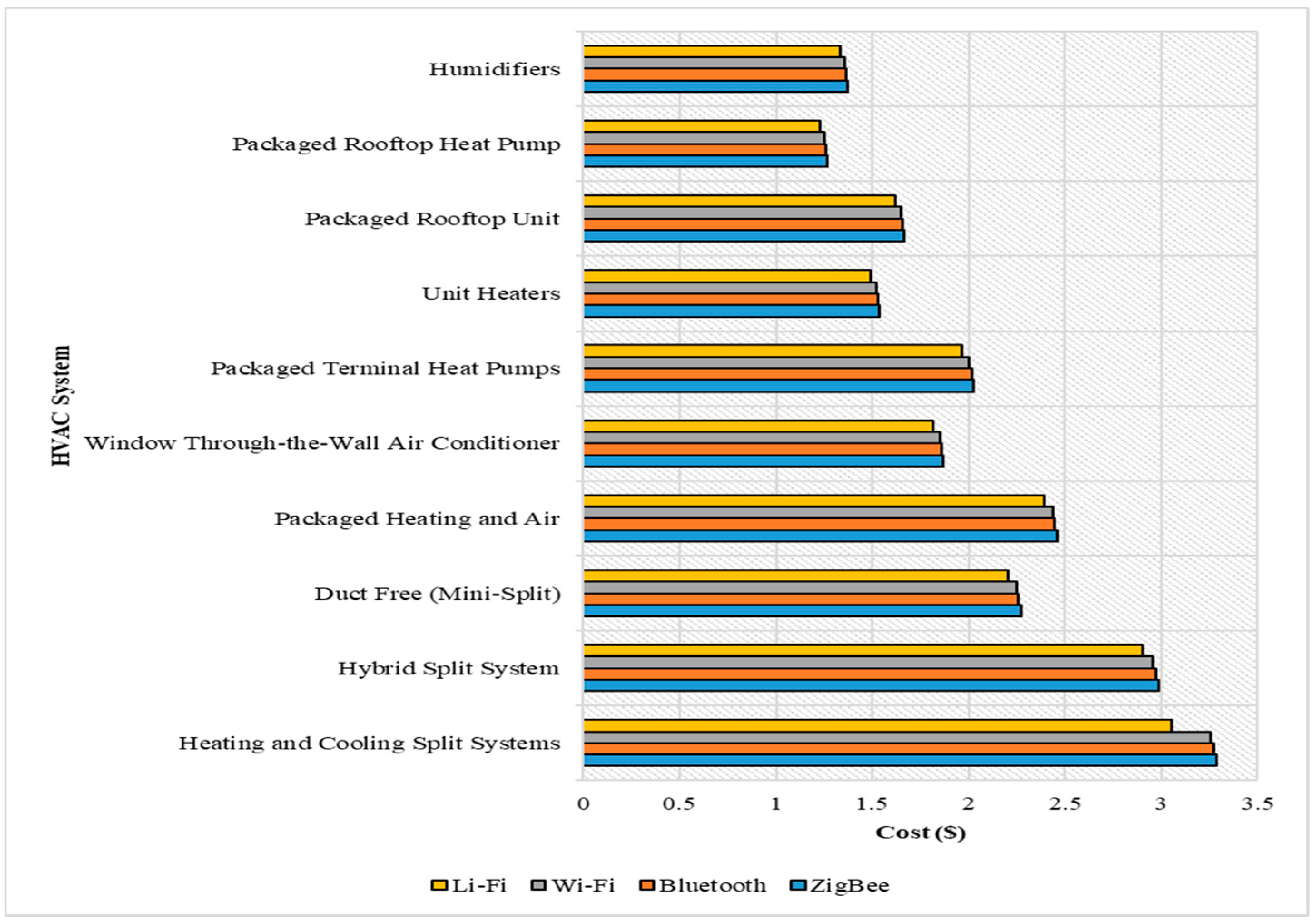
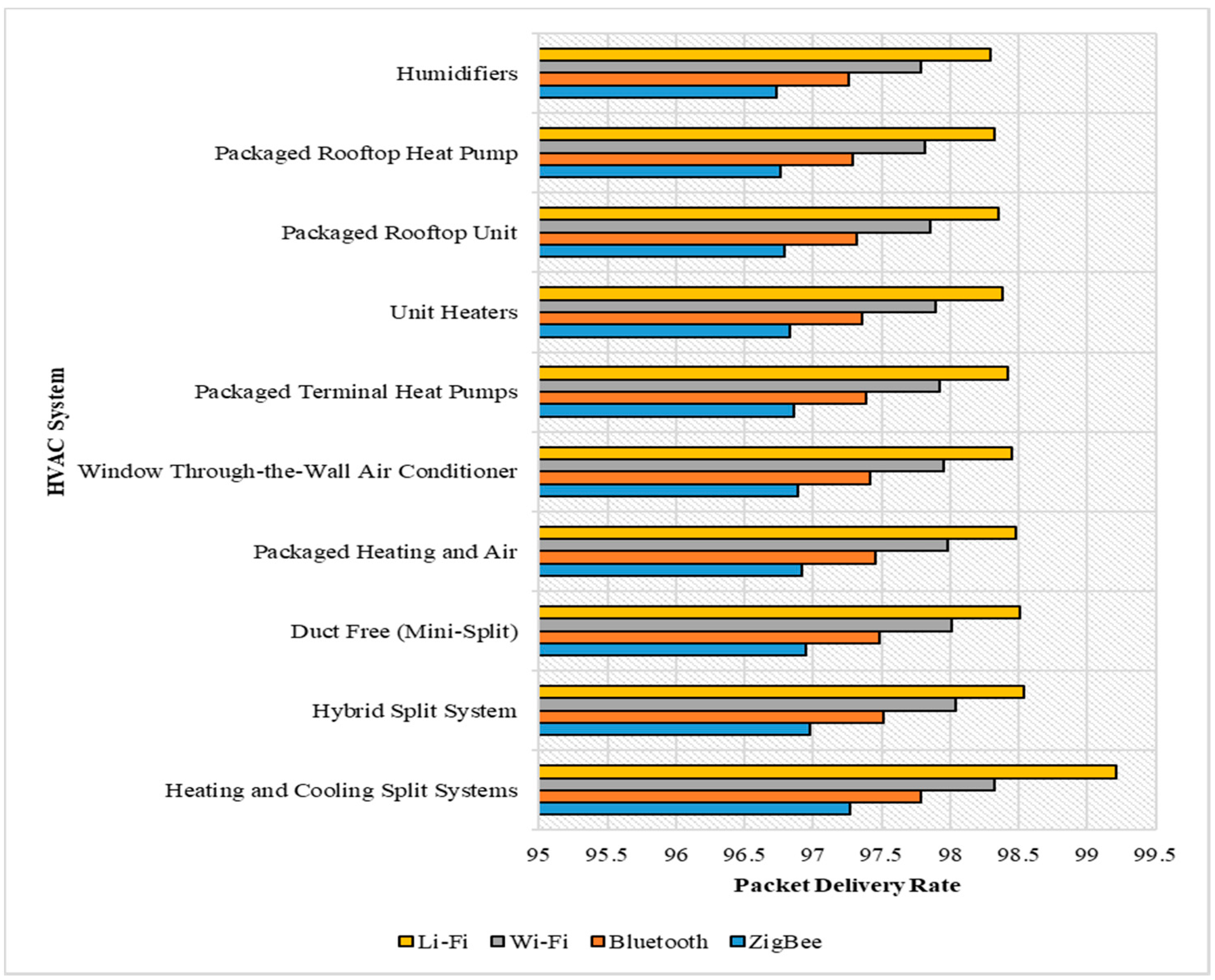
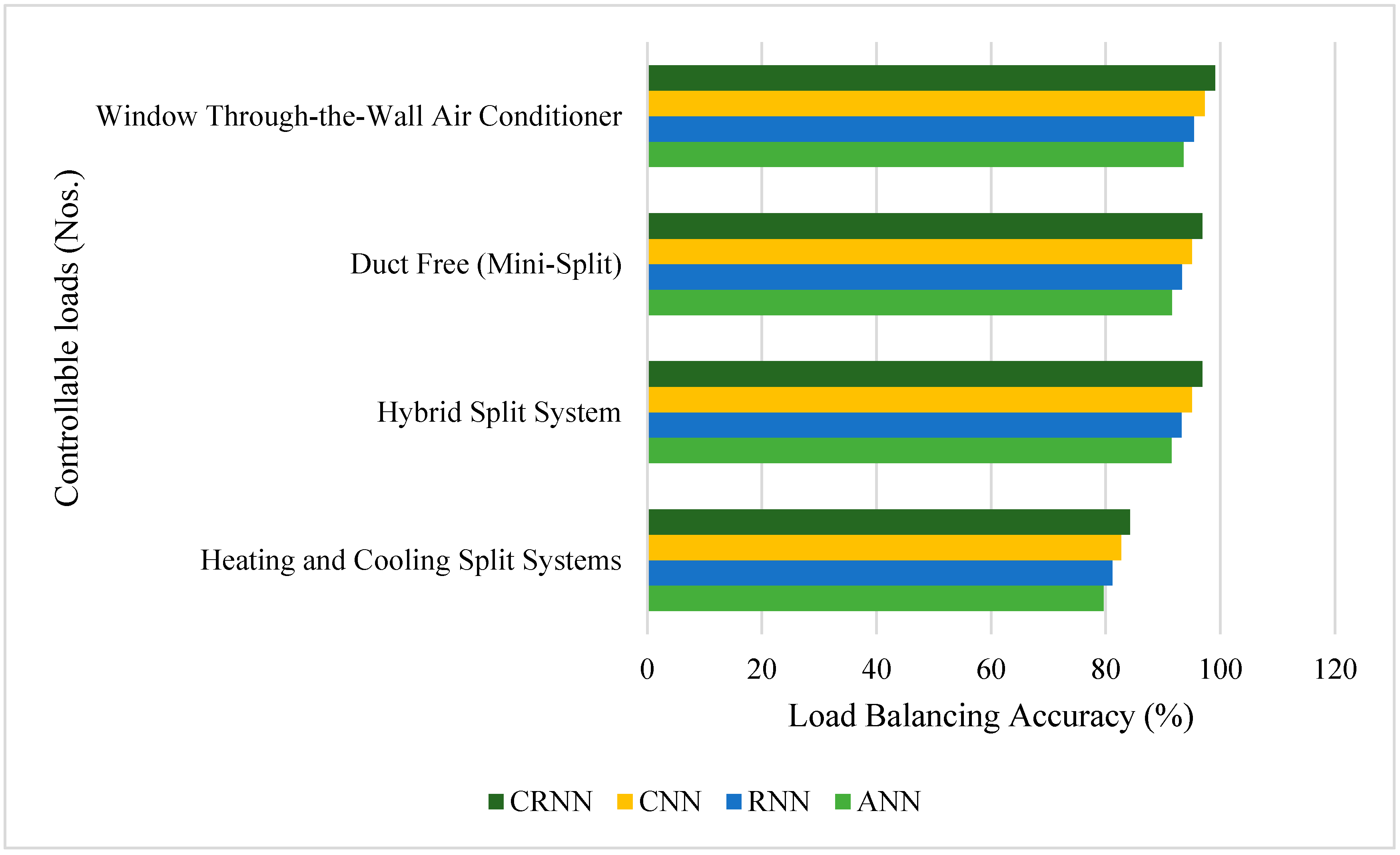
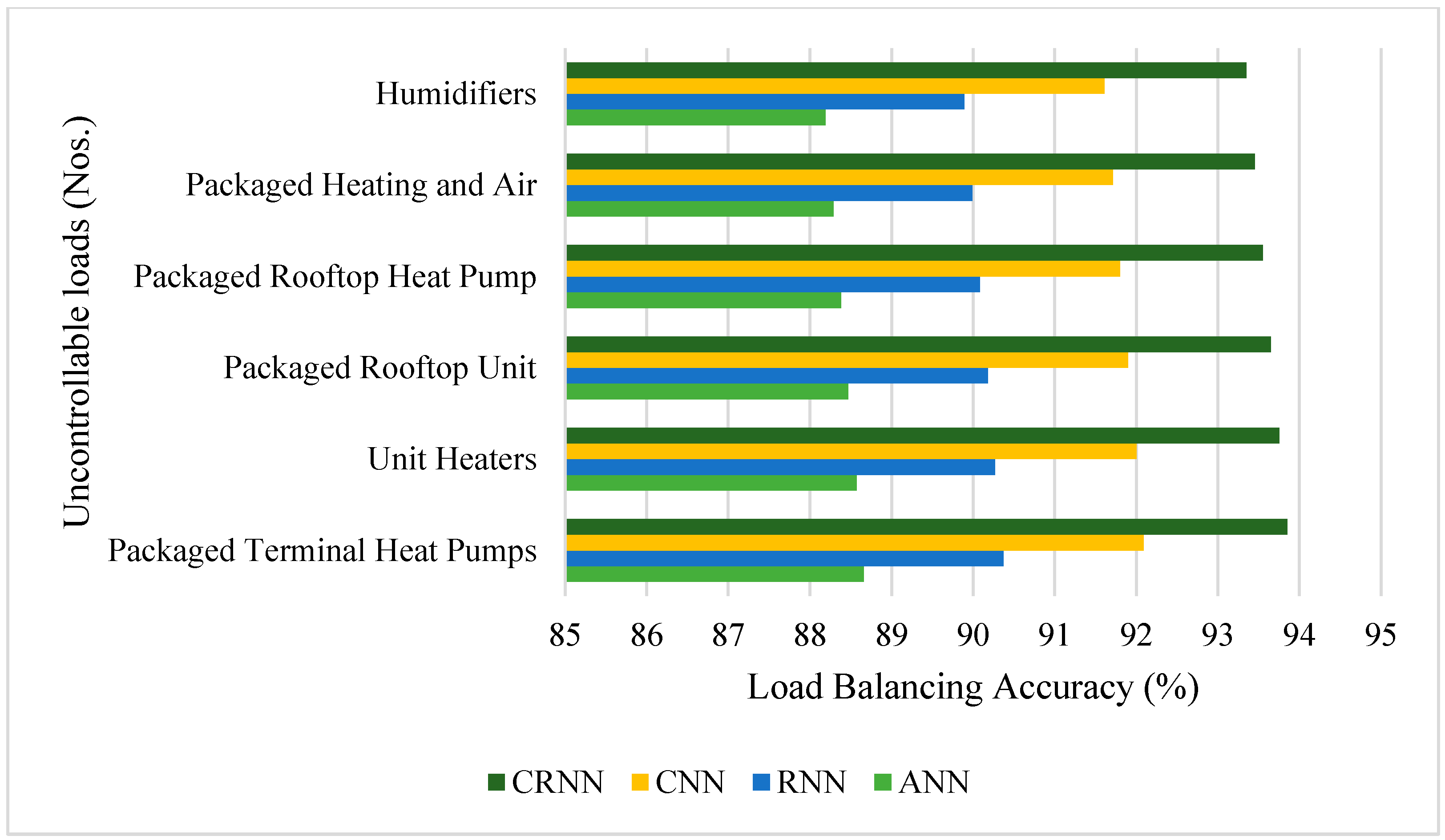
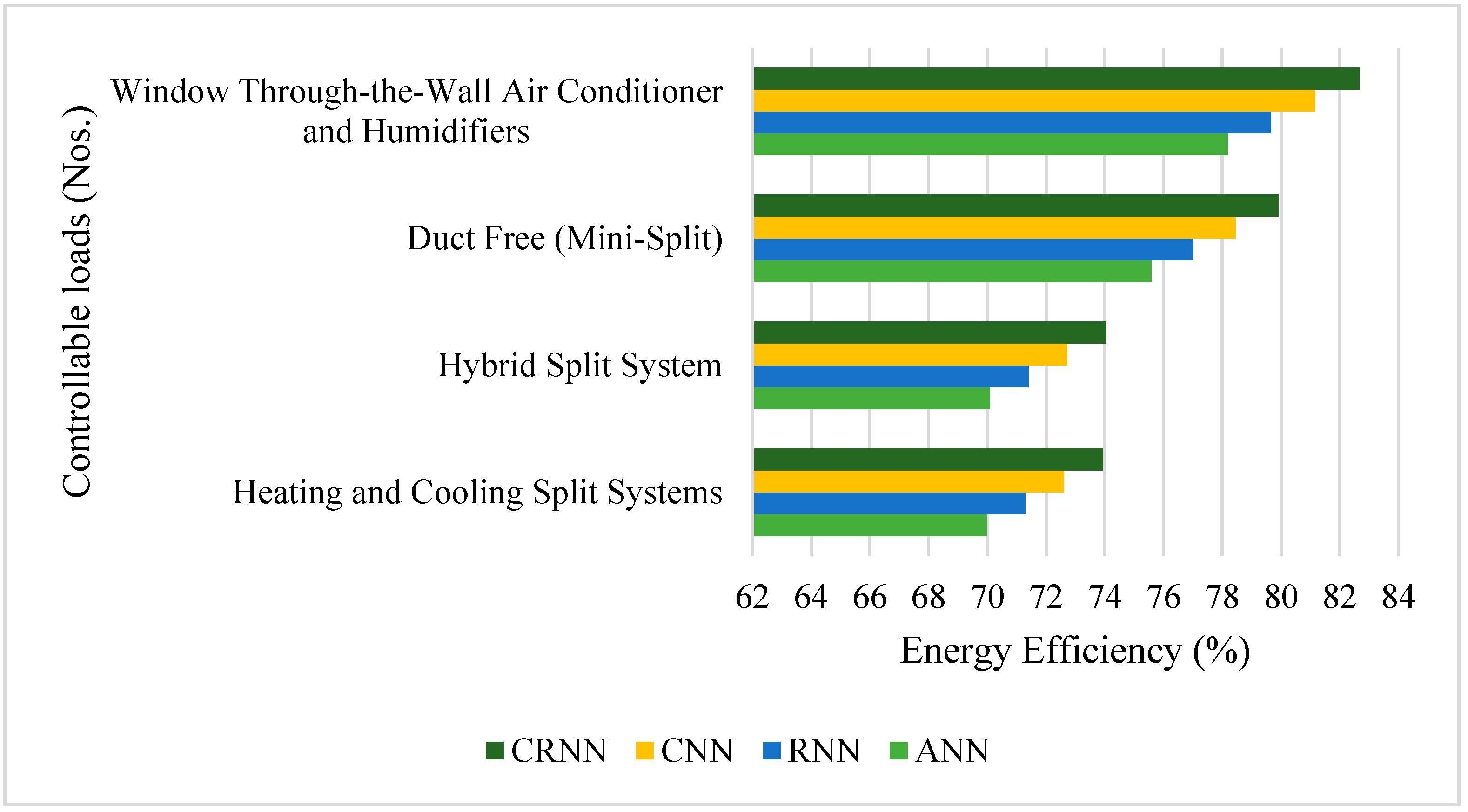

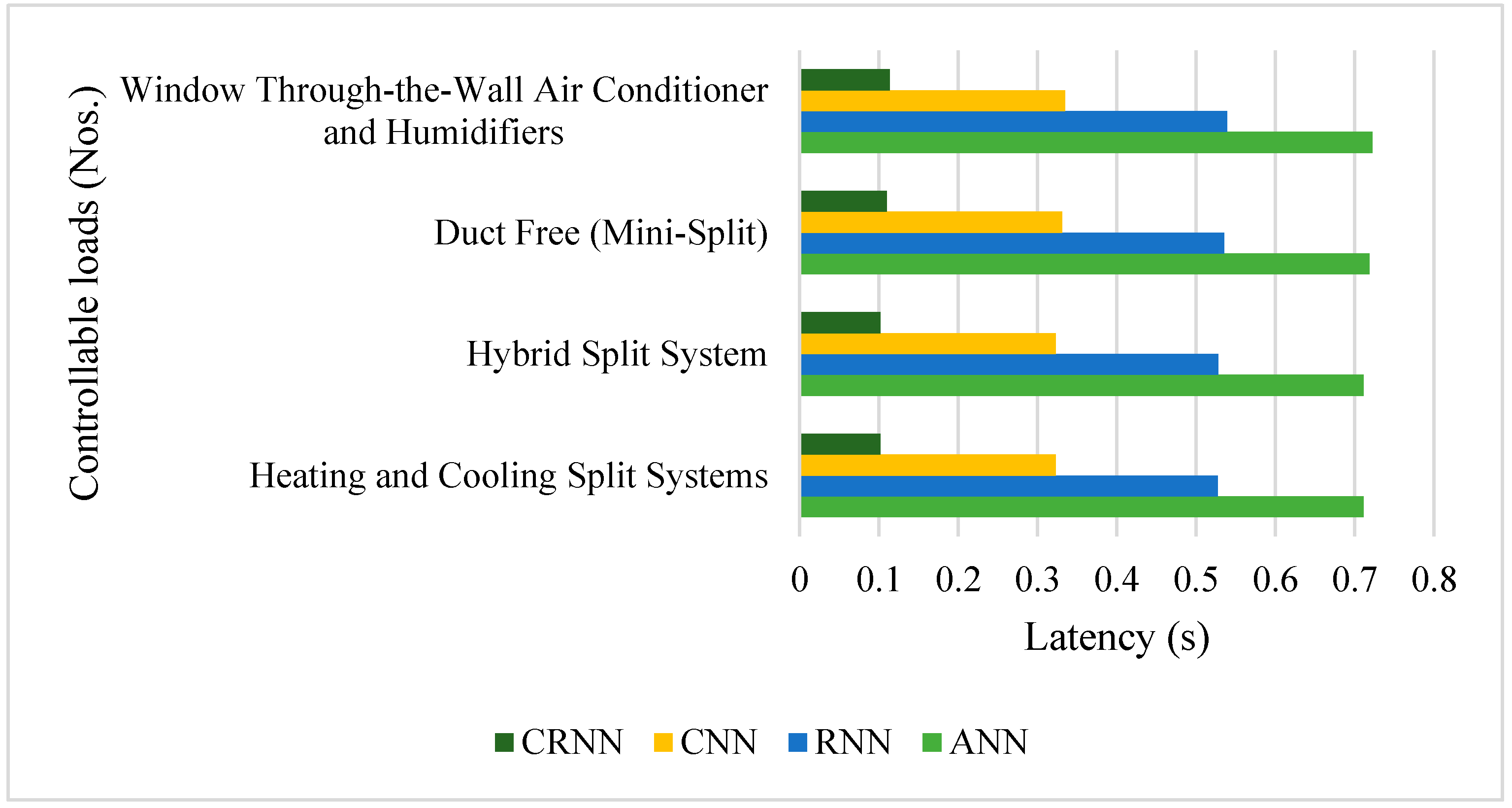
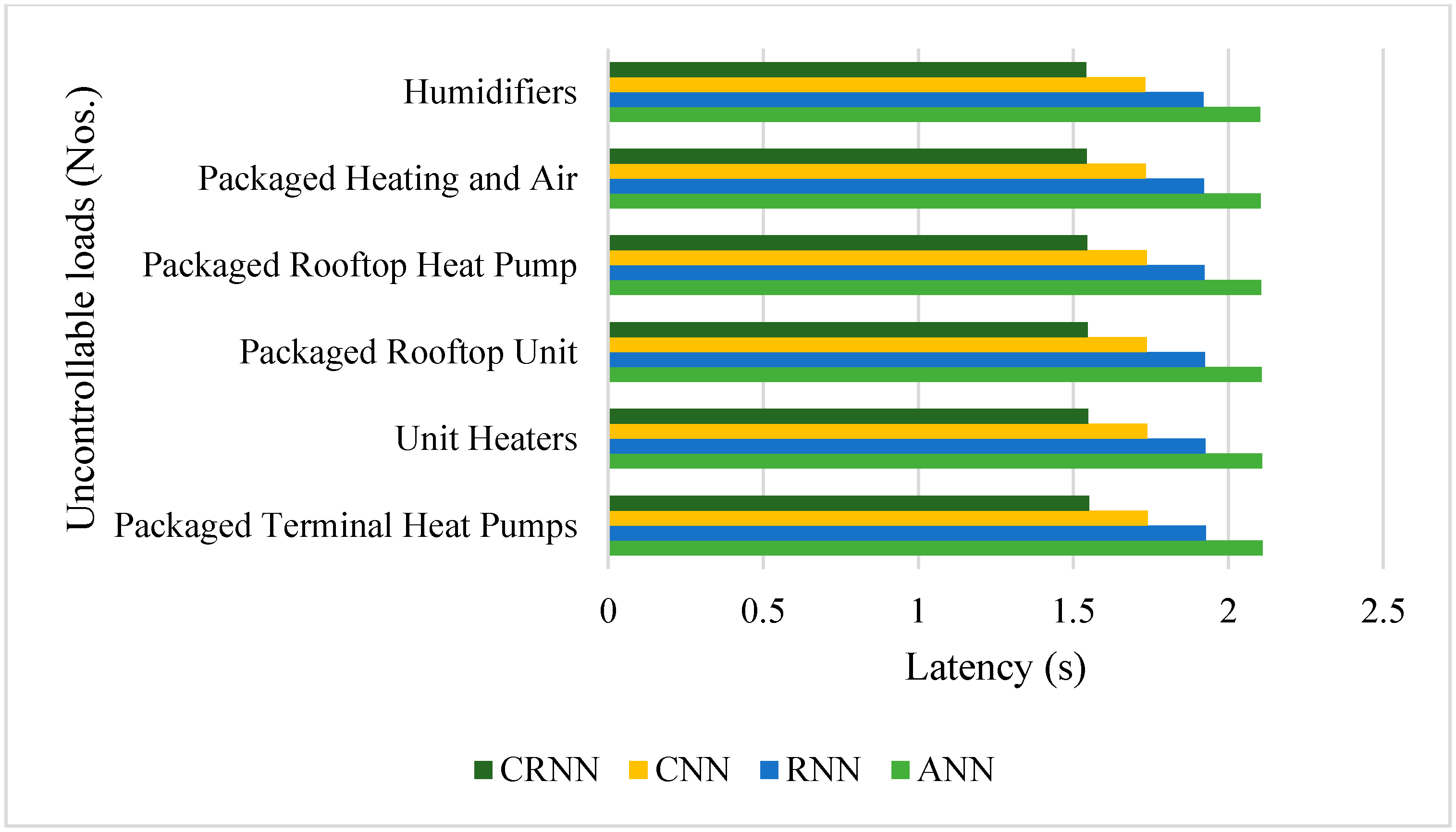
| Controllable Loads (Nos.) | ANN | RNN | CNN | CRNN |
|---|---|---|---|---|
| Heating and Cooling Split Systems | 53.89 | 64.14 | 67.12 | 940 |
| Hybrid Split System | 52.81 | 62.85 | 65.77 | 921 |
| Duct Free (Mini-Split) | 52.81 | 62.85 | 65.77 | 921 |
| Window Through-the-Wall Air Conditioner and Humidifiers | 53.04 | 63.12 | 66.06 | 925 |
| Uncontrollable Loads (Nos.) | ANN | RNN | CNN | CRNN |
|---|---|---|---|---|
| Packaged Terminal Heat Pumps | 53.32 | 64.15 | 66.63 | 931 |
| Unit Heaters | 53.17 | 64.16 | 66.15 | 930 |
| Packaged Rooftop Unit | 53.34 | 64.31 | 66.31 | 929 |
| Packaged Rooftop Heat Pump | 53.50 | 64.47 | 66.46 | 928 |
| Packaged Heating and Air | 53.67 | 64.62 | 66.61 | 927 |
| Humidifiers | 53.84 | 64.78 | 66.77 | 926 |
| ANN | RNN | CNN | CRNN | |
|---|---|---|---|---|
| Input nodes | 11 | 11 | 11 | 11 |
| Hidden nodes | 45 | 45 | 45 | 53 |
| Output nodes | 1 | 1 | 1 | 1 |
| Learning rate | 0.38 | 0.39 | 0.41 | 0.45 |
| Momentum | 0.55 | 0.57 | 0.60 | 0.65 |
| Training loss (MSE) | 2.1 × 10−5 | 5.2 × 10−6 | 4.1 × 10−6 | 1.5 × 10−7 |
Publisher’s Note: MDPI stays neutral with regard to jurisdictional claims in published maps and institutional affiliations. |
© 2021 by the authors. Licensee MDPI, Basel, Switzerland. This article is an open access article distributed under the terms and conditions of the Creative Commons Attribution (CC BY) license (http://creativecommons.org/licenses/by/4.0/).
Share and Cite
Bhatt, D.; D, D.; Hariharasudan, A.; Lis, M.; Grabowska, M. Forecasting of Energy Demands for Smart Home Applications. Energies 2021, 14, 1045. https://doi.org/10.3390/en14041045
Bhatt D, D D, Hariharasudan A, Lis M, Grabowska M. Forecasting of Energy Demands for Smart Home Applications. Energies. 2021; 14(4):1045. https://doi.org/10.3390/en14041045
Chicago/Turabian StyleBhatt, Dhowmya, Danalakshmi D, A. Hariharasudan, Marcin Lis, and Marlena Grabowska. 2021. "Forecasting of Energy Demands for Smart Home Applications" Energies 14, no. 4: 1045. https://doi.org/10.3390/en14041045
APA StyleBhatt, D., D, D., Hariharasudan, A., Lis, M., & Grabowska, M. (2021). Forecasting of Energy Demands for Smart Home Applications. Energies, 14(4), 1045. https://doi.org/10.3390/en14041045








